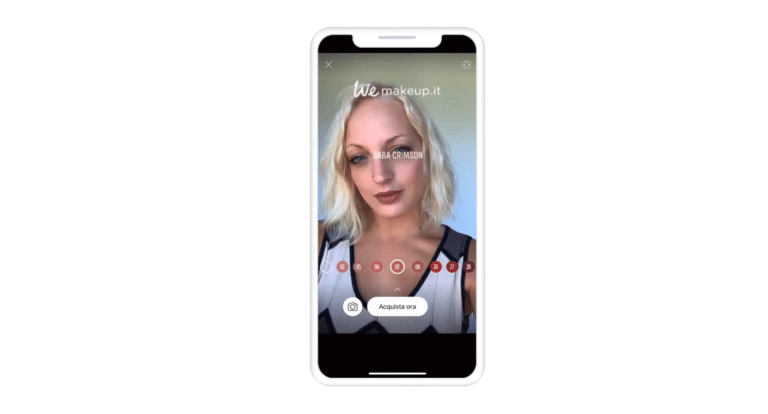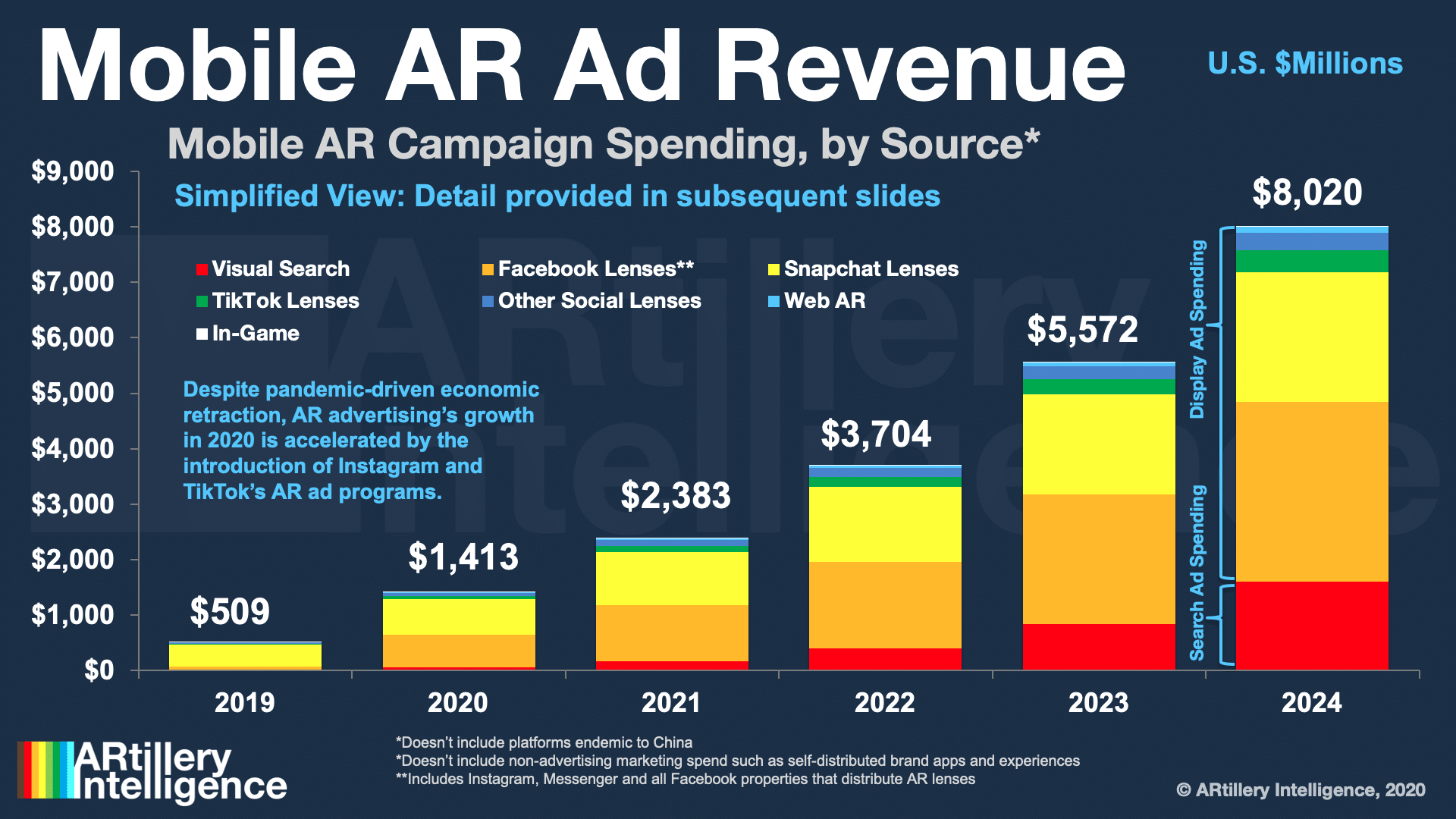
![]() This post is adapted from ARtillery Intelligence’s report, AR Advertising Deep Dive, Part I: The Landscape. It includes some of its data and takeaways. More can be previewed here and subscribe for the full report.
This post is adapted from ARtillery Intelligence’s report, AR Advertising Deep Dive, Part I: The Landscape. It includes some of its data and takeaways. More can be previewed here and subscribe for the full report.
AR continues to evolve and take shape as an industry. Prominent sectors include industrial AR, social, gaming, and shopping. But existing alongside all of them is AR advertising. This includes paid/sponsored AR lenses that let consumers visualize products on “spaces & faces.”
Advertising is one of the most lucrative AR subsectors, on pace to reach $1.41 billion this year and $8.02 billion by 2024. These figures measure the money spent on sponsored AR experiences with paid distribution on networks like Facebook and Snapchat.
As we’ve examined in past reports, the factors propelling this revenue growth include brand advertisers’ growing affinity for AR. Its ability to demonstrate products in immersive ways resonates with their creative sensibilities, transcending what’s possible in 2D formats.
Beyond that high-level appeal, there’s a real business case. AR ad campaigns continue to show strong performance metrics. This was the case in “normal” times and has accelerated during the COVID era when retail lockdowns compel AR’s ability to visualize products remotely.

Reach Advantage
Picking up where we left off last week in defining Facebook’s AR platform play and developing ad business, it’s time to zero in on its diversified approach. Though its flagship channel is the News Feed, AR is making its way to a range of Facebook-owned properties and apps.
For example, Facebook Messenger is a growing channel. And for AR, it means access to 1.2 billion users, some of whom follow and converse with brands. This can offer an engaged audience for brands to reach consumers and drive them towards e-commerce transactions.
Nike went this route with an AR virtual showcase for its Kyrie 4 shoe drop. It included 360-degree product visualization that flowed right into transactions, causing the shoe to sell out in less than an hour. This brings immersive product views where consumers already engage with brands.
Other AR integrations in Messenger include ASUS’ ZenPhone 5 virtual unboxing, which saw 10x greater engagement compared with its non-AR campaigns. Kia likewise saw a 46 percent boost in dealer inventory searches, as well as phone calls from its car visualization campaign.
Beyond Messenger, Facebook Portal is increasingly integrating AR. Though it hasn’t offered sponsored experiences, the potential is there. There have been many natural use cases developed such as animated face filters for storytelling to children (think: remote grandparents).
Sparking Innovation
A question that sprouts from all of the above is what tools does Facebook offer developers, creative agencies and brand advertisers? Just like Snap’s efforts to increasingly cater to lens creators (which in turn fuel user engagement and ad dollars), Facebook has a parallel path.
This all comes together in its developer platform, Spark AR Studio. As examined above, it’s attracted advertisers like Nike and Michael Kors. Its main goal with the platform is to offer something that’s easy to use and offers distribution scale to reach-driven brands.
“Because it’s delivered through the Facebook camera, you have potential to reach 1.5 billion people,” said Facebook’s Elise Xu at AWE. “We want to expand that [by] growing the inventory of AR content and giving developers the ability to make AR [for] more people and more channels.”
Regarding ease of use, programming isn’t required to make AR experiences on Spark AR Studio. And it’s doubling down on that strategy by making it easier to import AR graphics. A partnership with Sketchfab, for example, makes it easy to import thousands of 3D objects.
About Face
Facebook is meanwhile evolving its interactions for augmenting people (front-facing camera), and the physical world (rear-facing camera), similar to Snap. For example, it’s making advertiser-friendly enhancements, such as better face-tracking for trying on style items.
“We launched a high-fidelity tracker that tracks 30 percent more points on the face,” said Xu. “It enables more precision and accuracy around eyes and the mouth, and this is important for realistic makeup effects […] one of the major verticals we’re tackling with that is cosmetics.”
Facebook’s Location AR meanwhile works towards geographically-anchored AR graphics that carry location relevance. This will be a key value-driver in AR, tied to the concept of geographic scarcity. And it carries a lot of the same benefits and appeal as Snapchat’s Landmarkers.
“As AR evolves and expands, it’ll become more important for these experiences to be location relevant, and to be particularly tied to certain locations so they feel like they’re part of that place,” said Xu. “Location can be as broad as a country or as specific as a particular address.”
Last among Facebook’s overarching AR initiatives is broadening distribution. This is a numbers game to attract developers who are deciding where to apply resources and get the most impact. And the next untapped frontier for AR among Facebook’s properties: the mighty Instagram.
We’ll pause there and circle back in the next installment to continue the discussion of how Facebook will apply AR to build on the visual shopping and product discovery use case it’s already cultivated at Instagram. It could be AR’s sleeping giant. Check out the full report here.
